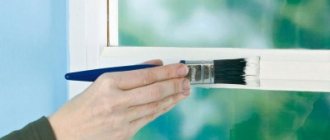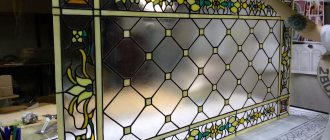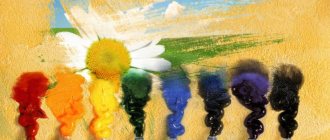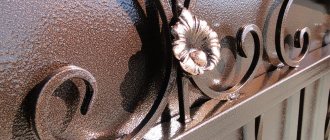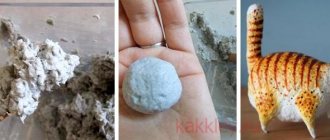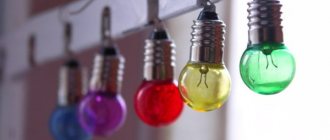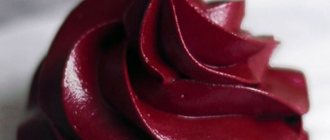The lighting of a room creates its atmosphere and regulates the emotional mood of its owners and guests. This way you can create a work room, or vice versa, a relaxation area. To decorate a space, lighting of different colors is often used, but its price is much higher than the price of standard lighting fixtures. Because of this, you need to learn how to paint the light bulb yourself.
Effective painting methods
In order to change the color of a product, it is recommended to use highly effective painting methods. The best solution is to use specialized paint, which is created specifically for painting glass objects.
Ballpoint pen paste
If you don’t have time to find special paint, you can use ballpoint pen paste. To carry out staining using this method, you must perform the following steps:
- Take the stick with the paste.
- Remove the tip and extract the paste.
- Using a brush, apply the paste to the light bulb.
You can use either a blue or any other pen as a source of paint. The final result will depend on the amount of paste applied. It is worth understanding that using only ink from a ballpoint pen you will not be able to perfectly darken the product.
Nail polish
Using nail polish, low-power light bulbs are painted that do not heat up very much (the temperature during operation does not exceed 100 degrees C). The varnish has pronounced adhesion and durability. It can also be used to paint the entire surface evenly. You can use varnishes of any color, from yellow to red and green. Clear varnishes can be used as a base for other colorants. After applying the varnish, any other paint will adhere much better and with higher quality to the surface of the light bulb.
See also
How to paint different surfaces with your own hands to match the color of wood, instructions
PVA
PVA glue is a good base for applying any coloring matter. If a high-quality result is required, it is recommended to create a layer of PVA before applying paint. Next, you can color the light bulb with ballpoint pen paste or special ink.
Auto enamel
Automotive enamel is a specialized paint that is sold in the form of an aerosol. Its advantages are good adhesion, convenience, high application speed and durability. Auto enamel is applied in a thin layer to achieve the desired darkening effect. You can find paint of any color on the market without any problems.
Application is carried out from a distance of 30-50 cm. Before this, the can is thoroughly shaken. It is important to make the layer thin so that the glass of the light bulb does not lose its transparency. If the layer is too thick, light will not pass through it.
Stained glass paints
Stained glass paints are created specifically for painting glass objects. With their help, you can give the glass the desired color while maintaining its transparency. To change the color of the light bulb, water-soluble stained glass paints are used that can withstand high temperatures.
Paints are sold in tubes. Substances must be applied in strict accordance with the instructions. You will first need to prepare the surface by cleaning and degreasing it. To give the light bulb a special look, purchase fluorescent paints with sparkles.
Tsaponlak
Tsaponlak is a varnish that is used to coat metal products and microcircuits to protect them from negative external influences. It is possible to purchase both transparent and colored tsaponlac. Using a colored liquid, you can try to paint a light bulb. The advantage of this varnish is resistance to high temperatures and wear resistance. The downside is the small selection of colors (only red and green tsaponlaki are available for selection).
Organosilicon
Organosilicon paints are characterized by extremely high heat resistance. They can be applied to coatings, which will subsequently heat up to temperatures above 500-600 degrees C. Organosilicon is used to color powerful light bulbs, which become very hot during operation. Before staining, it is recommended to dilute the dye with a solvent, otherwise the glass will be darkened too much. You need to act based on the instructions for the specific silicone-based paint.
See also
Consumption rates for acrylic paints per 1 m2 for different surfaces and examples
What is plexiglass, what and how is it made from, what are the characteristics of the material?
Plexiglas is a plastic made from the polymer methyl methacrylate. Its second name is plexiglass. The material was invented in Germany in 1901 by chemist Otto Roehm. The new material had many advantages, but it began to be widely used and entered the commercial market only in 1933.
Pros of plexiglass:
- high transparency (plexiglass transmits 93% of light rays versus 80% for glass);
- strength (5 times stronger than glass);
- flexibility (plexiglass is easier to give the desired shape);
- light weight (makes it possible to produce large-area panels).
Plexiglas also has disadvantages. It is easy to scratch, it becomes electrified and attracts dust, and when exposed to the sun for a long time it turns yellow.
Plexiglas is used in various fields - from medicine to interior decoration. Plexiglass is cheaper than regular glass and safer; any ornament or inscription can be applied to its surface, so decorative panels and billboards are often made from it.
Which means are not suitable?
Not all dyes are suitable for coloring a simple light bulb. The complete list of products that cannot be used for coloring depends on the specific purposes. To obtain the most attractive decorative result, it is necessary to use stable, heat-resistant stained glass paints, silicone or tsaponlac. To quickly create an anti-vandal lamp, paste from a pen is suitable.
Zelenka
Almost every person has a solution of brilliant green in their first aid kit. It is not recommended to use it for coloring, since it is not resistant to high temperatures, wears off quickly and does not allow for uniform darkening. When applied in a thick layer, the brilliant green darkens the glass too much, which is why the lamp ceases to fulfill its main task - illuminating the room.
Markers and felt-tip pens
It is extremely difficult to paint the entire surface of the glass with felt-tip pens and markers. In addition, they are extremely easy to wipe off the surface after application. Even alcohol-based markers can be removed from glass at the slightest touch. That is why coloring with felt-tip pens is not done when working with any lamps.
Expert opinion
Zakharova Irina Yurievna
Cleaning professional with 15 years of experience. Our best expert.
Ask a Question
Even if you manage to paint the glass with a marker, the product will greatly lose its brightness and will be unsuitable for lighting or creating light music.
Why is this necessary?
But in fact, why would a person of sound mind and good memory paint lamps?
The list of possible reasons is quite impressive.
- The most obvious motive is the fight against theft . Everyone is familiar with the problem of dark entrances. The cause of darkness in most cases is theft of a lamp. Painted in any color, it will become unsuitable for sale on the market or for lighting an apartment.
- The construction of color music is another case when it is impossible to do without colored light sources. A reasonable minimum is three lamps of different colors.
Captain Obviousness suggests: in this case, instead of colored lamps, you can use color film filters.
- All kinds of lighting systems for instrument panels and dials with a colored light source look much more impressive.
Why not just get random colored lamps? Do you often see them in hardware stores? Where they are, their price differs from ordinary white ones by 2–3 times.
Colored light bulbs are rare and quite expensive exotics.
How to paint an LED lamp
The method of painting an LED lamp depends on the type of its surface. Because this type of product generates less heat, more coloring agents are available. Even those dyes that can withstand only slight heating up to 100 degrees C are suitable. The main parameter that you need to pay attention to when selecting paint is its transparency and adhesion to glass. To preserve the brightness of the product to the maximum, both ballpoint pen paste and tsaponlak are suitable. There is no need to use expensive heat-resistant stained glass paint.
See also
Technology for painting wooden walls and suitable compositions, calculation of consumption
Problems
There is only one problem with painting light sources - their temperature. Let's give some values.
| Type | Surface temperature |
| Incandescent lamp, 25 watt | 100С |
| Incandescent lamp, 40 watt | 150С |
| Incandescent lamp, 75 watt | 250С |
| Halogen, 275 watts | 550 C |
| Energy saving (compact fluorescent) | 100С |
| LED | 35 – 50С |
It is clear that dyes not intended for high temperatures will quickly fade in such conditions; a layer of paint will remain transparent for only a few minutes. Compact fluorescent and LED lamps, however, heat up very moderately.
The plastic diffuser of the LED light bulb hardly heats up. Only the power converter gets noticeably warm.
Please note: halogen light sources cannot be painted. At all. A decrease in the transparency of the bulb will lead to its increased and, more importantly, uneven heating, which will inevitably lead to failure.
How to properly dim a night light bulb
Dimming a light bulb is a simple procedure if you choose the right dimming agent. Colored tsapon lacquer is perfect for this procedure. You can also darken it using nail polish. In order to simply reduce the brightness of the light, it is enough to use any neutral color. Blue colors are best for a night light.
You need to select a product depending on the type of product. For incandescent lamps, the substance must be heat-resistant, and the surface should not be darkened too much, as this can lead to overheating inside the lamp.
Solutions
Regular paint is not suitable for painting a lamp. Still, there are a number of solutions that can help solve the problem.
Ballpoint pen paste
To make a light bulb, for example, blue, you can use regular ballpoint pen paste.
You can do this as follows:
- Remove the tip containing the ball from the rod.
- Blow out the rod. This will help you extract the paste onto a paper sheet.
- Hold the lamp by the base and rub the paste onto the bulb.
In one of the Soviet technical magazines, the following method was proposed: dilute the paste in acetone, and apply the resulting liquid to the flask with a brush. This option is good because it allows you to control the saturation of the paint. However, keep in mind that liquid paint is difficult to apply on a smooth glass surface.
The light bulb can be painted using regular quick-drying nail polish. However, it should be remembered that the varnish can withstand temperatures up to 200 degrees, and then it begins to flow.
Only economy lamps or low power incandescent lamps can be varnished. The varnish is applied with the brush included with the tube. A cotton swab will do.
Moderately heated light bulbs are treated with PVA glue. The principle is the same as described above when it came to colorless varnish - creating a layer on which the dye will adhere well.
After the glue has dried, the surface is painted with ballpoint pen paste, inkjet printer ink or any water-soluble pigment.
Auto enamel
Automotive enamel is also suitable for painting light bulbs. Car enamels are packaged in aerosol cans. Like varnish, car enamel retains its performance characteristics at temperatures up to 200 degrees Celsius.
The enamel is applied from a distance of 30 - 50 centimeters. The paint layer should not be too thick, as in this case the bulb will lose its transparency.
Stained glass paints
Stained glass paints are used to paint light bulbs. In order to make the right decision about which colors can be used to paint a light bulb and which ones cannot, you should know that only water-soluble dyes are suitable for firing.
Such paints do not ignite when heated. Increasing the temperature only strengthens the coating. The only significant drawback of stained glass paints is their high cost. A small tube (50 grams) costs an average of 200 – 250 rubles.
Tsaponlak
To give the light bulb color, tsaponlak is suitable. This substance is sold in radio stores. Tsaponlak was originally designed to protect tracks and soldering from short circuits.
Tsaponlak contains the following components:
- nitrocellulose;
- organic solvent;
- dye to add color to parts (optional).
Tsaponlak has a certain heat resistance, since the temperature of the parts during their operation reaches 150 degrees. The disadvantage of tsaponlak is the limited choice of color.
The varnish does not contain a dye, and therefore the color will have to be created through other components. For example, to get a red lamp, you will need transparent zaponlak and red paste from a ballpoint pen. The procedure for staining with paste is the same as described above.
Organosilicon
Organosilicon-based paints and varnishes are used to impart color to coatings that are operated at elevated temperatures.
Organosilicon paints are the most resistant to heat and can withstand up to 600 degrees Celsius. Thanks to this, silicone retains its performance characteristics even on the hottest light bulbs.
To obtain a transparent coating, the composition must be diluted. The required solvent is always indicated on the container. For example, for the Russian brand KO-813 you will need solvent No. 646. Solvent or xylene will do.
In a home workshop, the choice is limited. As a rule, it all comes down to creating a base, onto which dye is then applied.
A more expensive option is stained glass or silicone paint, but the quality of the coating will be higher.
Comments
“Network publication “Woman’sDay.ru (Woman’sDey.ru)” Certificate of registration of mass media EL No. FS77-67790, issued by the Federal Service for Supervision of Communications, Information Technologies and Mass Communications (Roskomnadzor) December 13, 2022 16+.
Founder: limited liability company "Hirst Shkulev Publishing"
Editor-in-Chief: Dudina Victoria Zhorzhevna
Copyright (c) Hirst Shkulev Publishing LLC, 2022.
Any reproduction of site materials without the permission of the editors is prohibited.
Contact information for government agencies (including Roskomnadzor):
3. External lighting devices
3.1. The number, type, color, location and operating mode of external lighting devices do not meet the requirements of the vehicle design.
Note. On discontinued vehicles, it is permitted to install external lighting devices from vehicles of other makes and models.
3.2. Headlight adjustment does not comply with GOST R 51709-2001.
3.3. External lighting devices and reflectors do not work in the prescribed mode or are dirty.
3.4. Light fixtures do not have lenses or use lenses and lamps that do not match the type of light fixture.
3.5. The installation of flashing beacons, the methods of their fastening and the visibility of the light signal do not meet the established requirements.
3.6. The vehicle is equipped with:
in front - fog lights with lights of any color other than white or yellow, direction indicators with lights of any color except yellow or orange, other lighting devices with lights of any color except white, and retroreflective devices - of any color except white;
at the rear - reverse lights and state registration plate lights with lights of any color other than white, direction indicators with lights of any color except yellow or orange, other lighting devices with lights of any color except red, and retroreflective devices - of any color except red ;
The need to paint a lamp is usually dictated by decorative purposes. Some people want to create a color music system, others need multi-colored lighting for a dashboard or room.
Colored lamps are sold in hardware stores, but the cost of such products is several times higher than regular light bulbs.
Most often, the consumer decides to purchase a standard incandescent lamp and paint it the desired color. So the question arises: how to paint a light bulb? This will be discussed in the article.
Can I use brilliant green, marker, gouache, felt-tip pen?
Zelenka is actually an aniline dye dissolved in alcohol or water. Despite its rich emerald color, it is not suitable for tinting glass. The brilliant green is too liquid to stick to a smooth surface. An alcohol marker or felt-tip pen is suitable for applying drawings and signatures to the lamp, but with their help it is difficult to achieve a uniform background.
The option with gouache is acceptable only in cases where the light bulb does not have to be touched with your hands. Dried gouache gives a beautiful and bright color, but it wears off when you touch the surface it painted. If you want to paint a lamp with gouache, you should first screw it into the socket and only then cover it with paint.
